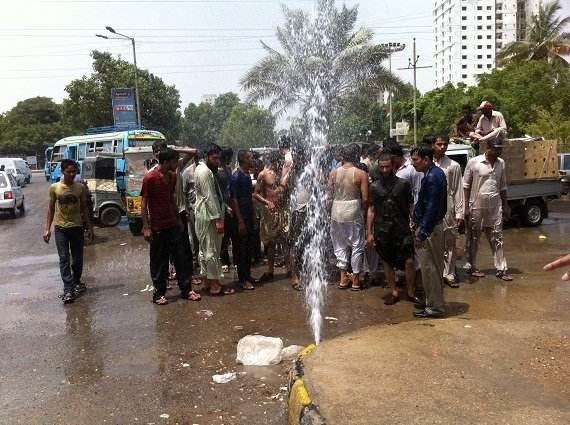HEADLINE
Why did So Many Die in Karachi's Heatwave?
"The city is experiencing it’s hottest summer in 30 years with temperatures as high as 45 degrees."
Naeem Sahoutara

Allah Dino rushes his 60 year old father into emergency. He is half unconscious and is finding it difficult to breathe.
“My father has been hit by sun stroke and he has breathing problems too,” he told the nurses.
This 200 bed Jinnah Postgraduate Medical Center is full.
The trauma center is also over-crowded.
The paramedical staffers are confused about which patient to treat first.
After ten minutes a nurse checks the pulse of Allah Dino’s father. She waves her hand to pronounce him dead.
In a corner of the hospital are the bodies of two disabled men.
“The cause of deaths is accidentally heatstroke and heat exhaustion. They had been brought here in unconscious condition, pulse-less and BP-less on arrival. They have collapsed while coming to the hospital,” said Dr. Seemin Jamali.
About 1,300 people have died across the country, many of them here in Karachi.
The city is experiencing its hottest summer in 30 years with temperatures as high as 45 degrees.
It’s also the Islamic fasting month and most people are not drinking or eating.
Some Muslim scholars have issued a decree that people don’t need to fast in extreme weather.
Dr. Seemin Jamali says people need to be drinking.
“I suggest that the people do not go out in the heat if not desired. And people may not exercise and use loose clothing, cotton clothing, use umbrellas and straw-hats or sun-heats to save themselves. They should be well hydrated and stay indoors,” she said.
But most of the deaths took place in the congested slum areas, where the electricity supply gets cut off for hours at a time.
Muhammad Bilal is the in-charge of the city’s largest mortuary run by the Edhi Welfare Foundation.
“Last night we announced that people should not bring any more bodies because we’ve run short of space to accommodate them. Now, we are just providing coffins and abolution and return the bodies,” he said.
The army has set up special heatstroke relief camps on the roads where they hand out wet towels that dip icy cold water.
Meteorologist Muhammad Haneef says what is happening is a sign of global warming.
“See the weather patterns have completely changed in the Pakistan. 20 years ago the country has the fall season lasting for maximum 150 days, but today it has expanded to 180 days. So the entire system of the winter and summer seasons has changed. The major losses of this change are the occurrence of the extreme weathers like the severe hot wave and cold wave, the floods, tornados. The changed patterns have increased the frequency of such natural disasters,” he said.
He says one of the reasons for the fast changing weather patterns is rapid deforestation. Pakistan has the highest deforestation rate in South Asia.
“Looking at the ongoing trends of the deforestation, pollution and urbanization it seems that more such disasters would take place in different parts of the country with more intensity in the future,” said Haneef.
- eng
- Naeem Sahoutara
- Pakistan heatwaves
- global warning
- environmental issue
Komentar (0)
KBR percaya pembaca situs ini adalah orang-orang yang cerdas dan terpelajar. Karena itu mari kita gunakan kata-kata yang santun di dalam kolom komentar ini. Kalimat yang sopan, menjauhi prasangka SARA (suku, agama, ras dan antargolongan), pasti akan lebih didengar. Yuk, kita praktikkan!